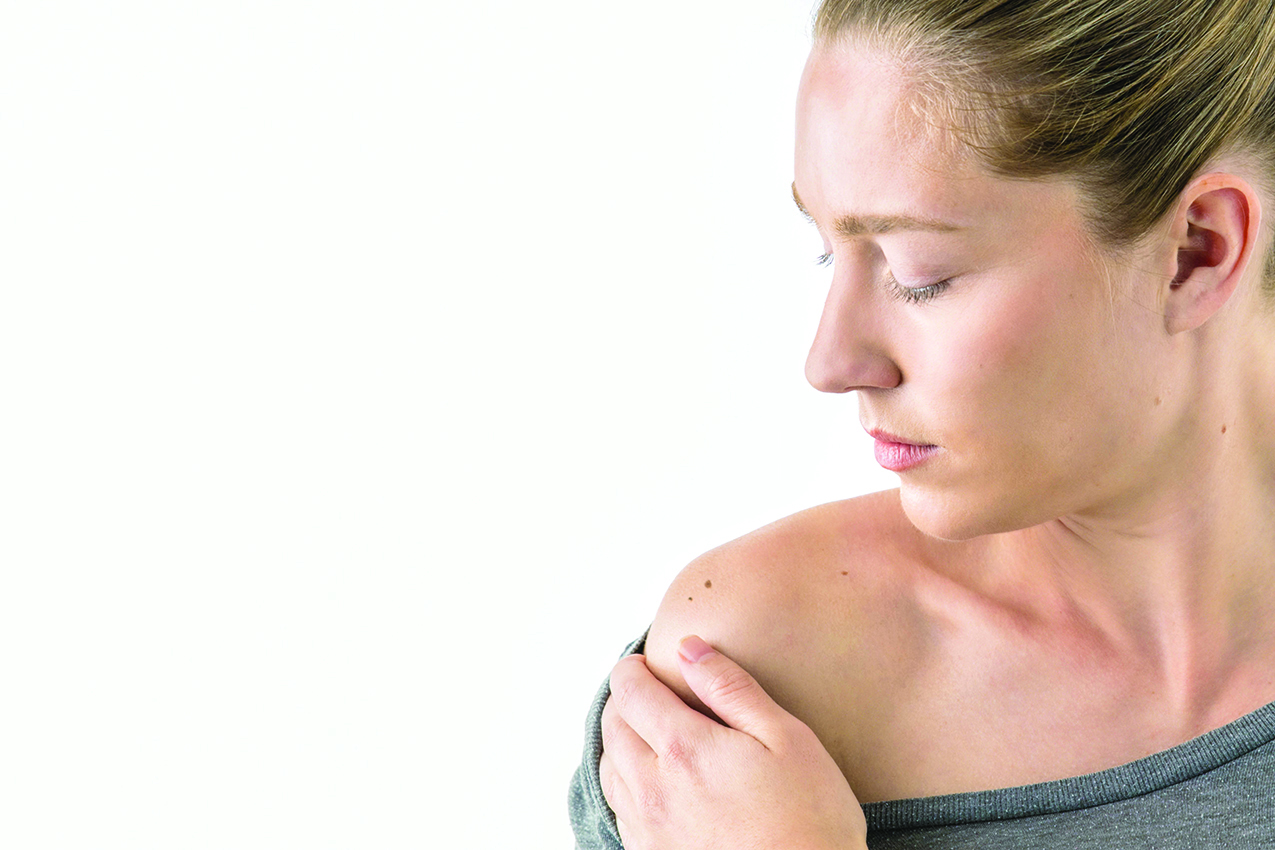HEALTHY LIVING
Sweatproof your make-up

Is there any more disastrous then spending an hour perfecting your makeup, leaving the house feeling like a million bucks and then stepping off a sticky train to find foundation dripping down your neck, smeared mascara and eyeshadow and liner that slides from your lid to your brow bone? This is what we call a major cosmetics meltdown.
Summer makeup is tricky, but fortunately there are tips you can follow to ensure your look is 100 percent sweat-proof. Here are 8 you should try tomorrow.
1. Look for “sweat-proof” makeup ingredients. Depending on your makeup collection, you may need to invest in a few new staples when temperatures begin to soar. “When looking for products that will keep your makeup from caking or sliding off at the first sign of sweat, opt for ones that are oil-free and silicone-based,” says beauty expert Julie Ricevuto of YouBeauty.com. “The silicone will act as a barrier between your skin and the humidity so that foundation won’t slide off or trickle into your pores. Avoid oil-based products since they will ultimately lead to a slick face, which will only be made worse by the sweltering heat.”
2. Start with great skin. The first step for any flawless makeup look involves taking good care of your skin. In the summertime, this also means prepping your skin in a way that makes it ready to wage war against the heat and humidity. “A strong skincare routine to keep your face clear and blemish-free will give you a beautiful canvas for applying your makeup,” Ricevuto says. “Use lightweight moisturizers to lock in hydration without starting your skin off looking slick. Also, choose long-wearing, oil- free formulas to keep your makeup budge-proof and smooth. If you end up getting a bit oily throughout the day, spot treat your shine with blotting papers instead of reapplying makeup over trouble spots.”
3. Don’t rely on your winter skincare routine. You will need to change things up so that the makeup you’ve applied to your skin reacts positively to the heat. “Skin will get greasier and pores will get clogged during the summer months due to sweat and sunblock,” says makeup artist Liz Fuller. “Start by using a gentle, non-soap cleanser (like Cetaphil) in the morning and evening to give your skin a thorough cleaning. Be sure to exfoliate several mornings a week, as well, to help clean out pores. Put the thicker creams and lotions at the back of your medicine cabinet and break out lighter, oil-free formulas to let skin breathe. (That includes sunblock.)”
4. Use a primer. Primers will change your life. If you’ve never used one, it’s invisible makeup that helps create a flawless foundation (even without actual foundation). “To ensure melt-proof makeup start by using a primer. Primers help to create a smooth canvas for makeup application and will keep makeup looking fresher longer. Look for primers that advertise as ‘matte.’ It will help to keep shininess and oiliness at bay. I like NYX Shine Killer primer,” says Fuller.
5. Opt for a tinted moisturizer. Foundation provides wonderful full coverage, but you’ll be lucky if a face full of heavy makeup lasts one August day. “Instead, use a lightweight tinted moisturizer or BB/CC cream,” Fuller says. “Just apply enough to even out the skin. I like Laura Mercier’s Oil-Free Tinted Moisturizer Broad Spectrum SPF 20.”
6. Dust a loose powder to set your makeup. After all of the hard work you put in to create a flawless face, it makes sense to protect it. “Loose powder will also help to absorb any oils in your skin,” Fuller says. “Even if you choose not to use any type of foundation or BB/CC cream, you should still dust the loose powder onto your skin to help create a barrier for oils and sweat. My favorite is NARS Soft Velvet Loose Powder.”
7. Spritz on a setting spray. Setting sprays aren’t just for professional makeup artists anymore. “It used to be that only a couple of brands were available at specialty makeup stores, but now setting sprays have gone mainstream and you can usually find them in your local drugstore,” Fuller says. “There are various types of setting sprays–just your basic spray that keeps makeup in place, sprays that give a dewy finish, or sprays with oil-control properties to give skin a matte finish. For summer I would recommend the matte finish spray. It helps to fight oiliness. My favorite is Urban Decay De-Slick Oil-Control Makeup Setting Spray.”
8. Control facial sweat with anti-perspirant! You don’t always need to purchase a high-end makeup product to do a job that can be done using something most of us already have in our medicine cabinet. “I do makeup for a lot of brides in the summer and sometimes they are just sweating in my chair,” Fuller says. “A lot of times it’s their upper lip that’s sweating or just underneath their breasts. I use a solid anti-perspirant on their upper lip to help stop the sweating. I swipe it over the skin and then pat it in and wait a few minutes. Same goes for under their breasts (although they need to use their own for that area!). It’s a quick and easy way to stop sweating. You can also use a spray anti-perspirant for feet that sweat in the summer heat. The spray is also good for behind the neck and on the inner thighs.”
For more beauty tips, check out Does washing your face prevent or cause breakouts? and how often you should really wash your hair.
[Photo: Imaxtree]
Source: Pintrest
HEALTHY LIVING
Understanding the hidden dangers of LDL (Bad) Cholesterol

(Family Features) These days, wellness information is practically everywhere you turn. Do this; don’t do that. Eat more of this; eat less of that. This is good for you; that is bad.
It can be hard to cut through all the noise, but the reality is, when it comes to something as serious as your heart health and LDL cholesterol – the “bad” cholesterol – ignoring it can be downright dangerous for your health.
According to the American Heart Association, about every 40 seconds, someone in the United States has a heart attack, and strokes occur at about the same frequency.
High LDL cholesterol, often called “bad” cholesterol, significantly increases your risk of heart disease.
A poll conducted by The Harris Poll for the American Heart Association revealed 75% of heart attack and stroke survivors reported having high cholesterol. Yet nearly half (47%) of heart attack and stroke survivors are unaware of their LDL cholesterol number. This lack of awareness shows more knowledge is needed to help survivors proactively manage their health.
In fact, knowledge is key to reducing your risk of heart disease. Understanding the impact of LDL cholesterol and knowing your LDL number can help you make informed decisions.
Cholesterol: The Good and The Bad
Cholesterol is a waxy, fat-like substance your body needs to build cells and produce hormones. However, not all cholesterol is created equal:
- LDL (low-density lipoprotein) Cholesterol: This is the “bad” cholesterol. When too much LDL cholesterol circulates in the blood, it can build up in the inner walls of the arteries that feed the heart and brain, forming plaque that can narrow and eventually block these arteries, leading to heart attack or stroke.
- HDL (high-density lipoprotein) Cholesterol: Known as the “good” cholesterol, HDL helps remove the “bad” cholesterol from the arteries, protecting against heart attack and stroke.
A Silent Threat
Many people think high cholesterol has obvious signs, but that’s not always the case. In fact, about half of U.S. adults and 42% of heart attack and stroke survivors mistakenly believe high cholesterol has clear symptoms. However, high LDL cholesterol typically doesn’t show any signs, which is why it’s known as a silent threat to your heart.
People who have had a heart attack or stroke are at higher risk of future cardiovascular problems, which is why it’s important to monitor your cholesterol regularly to help prevent future events.
It’s also important to know high LDL cholesterol can be genetic, meaning someone who eats a healthy diet and exercises regularly can still have high cholesterol. Additionally, the risk of high LDL cholesterol increases with age.
That’s why the American Heart Association’s “Lower Your LDL Cholesterol Now” initiative, nationally sponsored by Amgen, emphasizes the importance of regular cholesterol checks regardless of your weight, diet and physical activity levels. Knowing your LDL cholesterol number – and understanding the target levels based on your health history – gives you the opportunity to manage your health proactively. This enables you to make informed decisions to prevent future heart issues.
Know Your Number
You can reduce your risk of a heart attack or stroke by knowing and addressing your LDL cholesterol number.
Working closely with your doctor allows you to actively manage high LDL cholesterol – often a key risk factor you can help control – and together, you can develop a personalized treatment plan. Ask your doctor or health care provider for a cholesterol test to know your LDL number. Understanding your cholesterol number is the first step toward managing it effectively. If necessary, appropriate management of your LDL cholesterol can help reduce your risk of a heart attack or stroke.
Your doctor may also talk with you about your personal and family medical history; previous heart-related medical events such as a heart attack or stroke; lifestyle habits such as tobacco use, obesity, unhealthy living or aging; racial and ethnic backgrounds; and reproductive health.
Lower is Better
When it comes to your cholesterol, guidelines from the American Heart Association and the American College of Cardiology recommend “lower is better” to reduce your risk. Studies show that an LDL number or below 100 mg/dL is ideal for healthy adults.
If you have a history of heart attack or stroke and are already on a cholesterol-lowering medication, your doctor may aim for your LDL to be 70 mg/dL or lower.
Talk to your doctor about the right treatment plan for you. Positive lifestyle habits, such as exercising and eating a healthy diet, may also help.
However, if you’ve had a heart attack or stroke before, lifestyle changes alone may not be enough to lower your risk of another event. Your doctor may recommend cholesterol-lowering medications to protect your heart health.
Learn more about LDL (bad) cholesterol by visiting heart.org/LDL.
SOURCE:
HEALTHY LIVING
Save a life from stroke

(Family Features) Strokes can happen to anyone, at any age – even young people. Despite being one of the leading causes of death and long-term disability in the United States, strokes are largely preventable, treatable and beatable – if you can control your risk factors.
According to the American Stroke Association, a division of the American Heart Association, every 40 seconds, someone in the U.S. has a stroke. Keeping blood pressure in check, living a healthy lifestyle and knowing stroke warning signs may help protect you and your loved ones.
Here are key insights from the American Stroke Association’s Together to End Stroke initiative, nationally supported by the HCA Healthcare Foundation.
Controlling Risk Factors
Up to 80% of strokes may be preventable, according to the American Stroke Association. You can take action to prevent strokes by managing your risk factors, like high blood pressure, a leading cause and controllable risk factor for stroke and heart disease.
Other risk factors include diabetes and obesity, which can be kept in check with healthy lifestyle behaviors such as good nutrition. Quitting smoking and being physically active are important. Atrial fibrillation, or AFib, which is a quivering or irregular heartbeat, also increases stroke risk. In fact, people with AFib are five times more likely to have a stroke, according to the American Heart Association.
Preventing a Second Stroke
Nearly 1 in 4 strokes occur in people who had a previous stroke, sometimes because they don’t know what caused the first, making identifying the cause of the stroke a key step toward future prevention. Treatment depends on the type of stroke someone is having, which can be determined with a series of medical evaluations and tests.
Work with your health care professional to develop a plan that helps you move forward after a first stroke while preventing a second. This plan should include controlling risk factors, like achieving and maintaining healthy blood pressure, blood sugar and cholesterol levels.
“Preventing a second stroke is possible with the right approach,” said Teresita Casanova, MD, HCA Healthcare affiliated neurologist and American Stroke Association volunteer expert. “Taking medicines as prescribed, monitoring health numbers, and making small, consistent lifestyle changes can make a big difference. Stroke survivors should feel empowered to take control of their health and work with their care team to build a strong prevention plan.”
To help you in your journey, you can rely on tools such as the Heart & Stroke Helper, a free self-management app available for stroke survivors and their caregivers. The app allows patients to oversee their health in one place with features that track progress on lifestyle habits, manage medications, track health numbers, provide information about stroke and allow patients to connect with others for inspiration.
Find more ways to manage second stroke risk at Stroke.org

Act F.A.S.T.: How to Detect Signs of Stroke
Most adults in the U.S. don’t know the stroke warning signs, nor that stroke is largely treatable if you call 911 as soon as you recognize the symptoms.
Learning the acronym F.A.S.T. can help you recognize that someone may be having stroke symptoms so you can take life-saving action.
F: Face Drooping. Does one side of the face droop, or is it numb? Ask the person to smile. Is the person’s smile uneven?
A: Arm Weakness. Is one arm weak or numb? Ask the person to raise both arms. Does one arm drift downward?
S: Speech. Is speech slurred? Is the person unable to speak or hard to understand? Ask the person to repeat a simple sentence, like “The sky is blue.”
T: Time to Call 911. If you or anyone else shows any of these symptoms, call 911 immediately.
Photo courtesy of Shutterstock
SOURCE:
HEALTHY LIVING
How to conduct a skin care self-exam

Time spent soaking up the summer sun is one of the things that makes the season so appealing. Warm outdoor air has a calming effect that can make anyone feel more relaxed and comfortable.
As good as warm summer sun can feel, overexposure to the sun can be dangerous. The World Cancer Research Fund reports there were more than 330,000 new cases of skin cancer diagnosed across the globe in 2022. A significant percentage of skin cancer cases can be prevented, and prevention is a multifaceted process that includes skin care self-examinations. Self-exams do not take up much time, and individuals can speak with their physicians about how frequently they should check their skin for signs of skin cancer. The U.S. National Library of Medicine offers the following instructions for how to conduct a skin self-exam.
Choose the right time to examine your skin. The USNLM recommends conducting a skin exam after bathing. Women who routinely conduct breast self-exams can check their skin at this time as well.
Use a full-length mirror. ItÕs not always easy to examine skin throughout the body. But signs of skin problems can occur anywhere on the body, including areas that might be hard to see without help. If possible, conduct a self-exam of the skin in front of full-length mirror in a brightly lit room.
Identify what youÕre looking for. The USNLM notes you should be looking for any new skin markings. This includes bumps, moles, blemishes, and changes in skin color.
Pay close attention to preexisting moles. A potential sign of skin cancer includes moles that change over time. Examine preexisting moles to see if they have changed in size, texture, color, and shape.
Look for unusual moles. The USNLM characterizes certain moles as Òugly duckling moles.Ó These unique moles look and feel different from nearby moles and may be indicative of skin cancer. Speak with a dermatologist if a self-exam uncovers the presence of moles with uneven edges or differences in colors or asymmetric shapes. Moles that look different from one side to the other also should be brought to the attention of a dermatologist. Moles that do not stop bleeding or will not heal also merit examination by a skin care professional.
When the time comes to conduct the exam, the USNLM recommends following these steps:
- Look closely at your entire body, both front and back, in the mirror.
- Check under your arms and on both sides of each arm. Be sure to examine the backs of your upper arms, which can be hard to see.
- Bend your arms at the elbow, and examine both sides of your forearm.
- Examine the tops and palms of your hands.
- Examine the front and back of both legs.
- Examine your buttocks and between your buttocks.
- Examine your genital area.
- Examine your face, neck, the back of your neck, and scalp. Use both a hand mirror and full-length mirror, along with a comb, to see areas of your scalp.
- Examine your feet, including the soles and the spaces between your toes.
- Ask a person you trust to help examine hard-to-see areas.
Skin cancer poses a formidable threat, but many cases of the disease are preventable. Routine skin self-exams are a vital component of skin cancer prevention. TF256909
-

 NEWS3 years ago
NEWS3 years ago2 hurt, 1 jailed after shooting incident north of Nocona
-

 NEWS2 years ago
NEWS2 years agoSuspect indicted, jailed in Tia Hutson murder
-

 NEWS2 years ago
NEWS2 years agoSO investigating possible murder/suicide
-

 NEWS2 years ago
NEWS2 years agoWreck takes the life of BHS teen, 16
-

 NEWS2 years ago
NEWS2 years agoMurder unsolved – 1 year later Tia Hutson’s family angry, frustrated with no arrest
-

 NEWS2 years ago
NEWS2 years agoSheriff’s office called out to infant’s death
-

 NEWS2 years ago
NEWS2 years agoBowie Police face three-hour standoff after possible domestic fight
-

 NEWS3 years ago
NEWS3 years agoDriver stopped by a man running into the street, robbed at knifepoint






